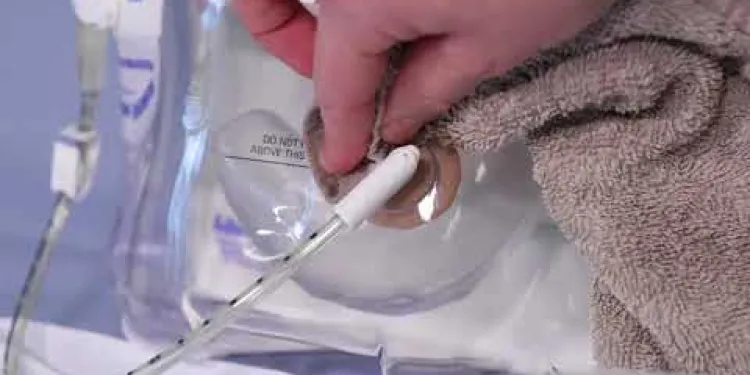
Find Help
More Items From Ergsy search
-

How do you attach a stoma bag?
Relevance: 100%
-

What is a stoma bag?
Relevance: 84%
-

What is a Stoma Bag?
Relevance: 78%
-

What are the types of stoma bags?
Relevance: 76%
-

Can you shower with a stoma bag?
Relevance: 76%
-

Do stoma bags require a prescription?
Relevance: 71%
-

What is the lifespan of a stoma bag?
Relevance: 71%
-

Why might someone need a stoma bag?
Relevance: 70%
-

Is a stoma bag visible under clothes?
Relevance: 68%
-

Can a stoma bag cause infections?
Relevance: 67%
-

What advancements have been made in stoma bag technology?
Relevance: 67%
-

How do you dispose of used stoma bags?
Relevance: 66%
-

What support is available for people with stoma bags?
Relevance: 65%
-

How often do you need to change a stoma bag?
Relevance: 64%
-

Can you wear regular clothing with a stoma bag?
Relevance: 64%
-

Stoma Care
Relevance: 61%
-

Bowel Cancer
Relevance: 46%
-

Can you participate in sports or physical activities with a stoma bag?
Relevance: 42%
-

Is it possible to smell the contents of a stoma bag?
Relevance: 29%
-

Are there special dietary restrictions for someone with a stoma bag?
Relevance: 27%
-

How do you manage gas with a stoma bag?
Relevance: 27%
-

How do you prevent skin irritation from the stoma bag?
Relevance: 23%
-

How long does a tick need to be attached to transmit Lyme disease?
Relevance: 22%
-

What should I bring with me when walking to work?
Relevance: 20%
-

What should you do if you find a tick on your body?
Relevance: 15%
-

What should I bring with me when visiting a food bank?
Relevance: 13%
-

What should I wear when walking to work?
Relevance: 12%
-

How can you differentiate nits from dandruff?
Relevance: 12%
-

What do nits look like?
Relevance: 12%
-

How is Lyme disease transmitted?
Relevance: 11%
-

Don't Fall for These 7 Cybersecurity Scams!
Relevance: 11%
-

What should I wear when walking to work?
Relevance: 10%
-

What should I do if I find bed bugs in my house?
Relevance: 10%
-

What items should I wash if I have bed bugs?
Relevance: 10%
-

How do lice lay nits?
Relevance: 10%
-

How do bed bugs enter my home?
Relevance: 8%
-

Why am I not receiving expected emails?
Relevance: 8%
-

What is shoplifting?
Relevance: 8%
-

Can nits survive on furniture or clothing?
Relevance: 8%
-

What kind of ticks carry Lyme disease?
Relevance: 8%
Introduction to Stoma Bags
A stoma bag is an essential part of life for many individuals following surgery that requires the diversion of bodily waste. In the UK, the attachment and management of a stoma bag is often explained by healthcare professionals, but understanding the correct procedure is vital for ongoing comfort and health.
Preparing to Attach a Stoma Bag
Before attaching a stoma bag, gather all necessary supplies including the stoma bag, a measuring guide, and stoma adhesive. Wash your hands thoroughly with soap and water to maintain hygiene. Ensure your skin is dry and clean. Inspect the stoma area for any signs of irritation or infection. It's important to have a well-fitting bag to minimize leakage and skin issues.
Measuring the Stoma
Use a stoma measuring guide to determine the size and shape of your stoma. The stoma will likely change in size following surgery and over time, so regular measurement is crucial. Cut the opening in the adhesive so it's approximately 1-2 mm larger than the stoma itself, ensuring a snug fit without causing pressure or restricting blood flow.
Attaching the Stoma Bag
Once you've prepared the adhesive, gently remove the backing paper from the flange. Position the newly cut aperture over the stoma without touching the sticky part with your fingers. Press the adhesive against your skin, starting at the bottom and working upwards, smoothing out air bubbles as you go. Apply gentle pressure for a few minutes to ensure a secure connection.
Securing and Checking the Bag
After the stoma bag is firmly in place, inspect the seal. Adjust the bag as needed to ensure it aligns well with your body contours. Attach any additional clips or closure systems if your bag isn't pre-sealed. Take a moment to ensure the bag can expand and fold comfortably under your clothing without obstruction. Some prefer using a support garment for additional security.
Maintaining Hygiene and Comfort
Change the stoma bag as recommended by your healthcare provider, typically every 1-3 days or immediately if it begins to leak. Clean the skin around the stoma gently with warm water; avoid soaps that could irritate or leave a residue. Pat the area dry before attaching a new bag. Drink plenty of water and eat a balanced diet to support stoma output consistency.
Conclusion
The successful attachment of a stoma bag involves preparation, precision, and ongoing care. With practice, the process becomes easier, contributing to a comfortable and confident lifestyle. If you encounter any issues, consult a stoma care nurse for tailored advice and support. Remember, living with a stoma bag can be managed effectively with the correct approach and care.
Introduction to Stoma Bags
A stoma bag collects waste from the body after certain surgeries. In the UK, doctors and nurses show people how to use it. Knowing how to use a stoma bag properly helps you feel comfortable and healthy.
Preparing to Attach a Stoma Bag
To put on a stoma bag, you need some supplies: the stoma bag, a guide to measure the stoma, and sticky stuff called adhesive. Wash your hands well with soap and water. Make sure your skin is clean and dry. Check the stoma area for redness or signs of infection. The bag should fit well to stop leaks and protect your skin.
Measuring the Stoma
Use a special guide to measure the stoma's size and shape. The stoma might change size after surgery, so measure it often. When you cut the adhesive, make sure the hole is just a little bigger than the stoma. This way, it fits well but doesn't squeeze too tight.
Attaching the Stoma Bag
After cutting the adhesive, pull off the paper backing. Gently put the hole over the stoma. Don’t touch the sticky part. Press the sticky part onto your skin starting from the bottom and moving up. Smooth out any air bubbles. Press gently for a few minutes so it sticks well.
Securing and Checking the Bag
Once the bag is on, check the seal to make sure it's tight. Move the bag around a little to make sure it fits your body. Use extra clips if your bag needs them. Make sure the bag sits well under your clothes. Some people wear a special support band for extra safety.
Maintaining Hygiene and Comfort
Change the stoma bag every 1-3 days, or if it leaks. Gently clean the skin around the stoma with warm water. Don’t use soaps that might irritate your skin. Dry the area before putting on a new bag. Drink lots of water and eat balanced meals to help your body work well.
Conclusion
Putting on a stoma bag takes practice, but it gets easier. It helps you feel comfortable and confident. If you have problems, talk to a stoma care nurse for help. With the right care, living with a stoma bag can be managed well.
Frequently Asked Questions
What is a stoma bag?
A stoma bag is a medical pouch worn over a stoma to collect waste from the body.
What supplies do I need to attach a stoma bag?
You will need a stoma bag, a skin barrier or wafer, scissors (if needed for cutting the barrier), and any additional adhesive if recommended.
How do I prepare my skin before attaching a stoma bag?
Clean the skin around the stoma with warm water and mild soap, then pat it dry completely.
How do I measure the stoma for the bag?
Use a stoma measuring guide provided with your supplies to measure the stoma size and cut the opening in the wafer to fit.
Do I need to cut the opening for the stoma bag?
Yes, if your stoma bag does not come pre-cut, you need to cut the opening in the wafer to fit around the stoma snugly.
How do I ensure the stoma bag fits securely?
Ensure the wafer opening fits closely around the stoma, press it firmly onto the skin, and check that the bag is attached correctly to the wafer.
Is it necessary to use adhesive remover or wipes?
Adhesive remover wipes can make it easier to remove the old wafer and clean the skin but are not always necessary.
What should I do if irritation occurs on the skin around the stoma?
Consult with a healthcare professional and consider using barrier creams or alternative products to protect the skin.
How do I remove the old stoma bag?
Carefully peel away the wafer from the skin, supporting the skin with the other hand to minimize irritation.
How often should the stoma bag be changed?
Frequency of change depends on the type of stoma, the individual's needs, and the type of stoma bag system used. Some may change it every 1-3 days.
Can I shower with a stoma bag?
Yes, most stoma bags are waterproof, allowing you to shower without needing to remove them.
How do I check for leaks in my stoma bag?
Regularly inspect the bag for signs of leakage. If you notice a leak, change the bag promptly.
What if my stoma changes size or shape?
Re-measure your stoma regularly and adjust the wafer size accordingly to ensure a secure fit.
Can I exercise with a stoma bag?
Yes, most people can continue exercising but might need specific products for added security during physical activities.
How can I reduce odor from my stoma bag?
Use odor-reducing products or choose stoma bags designed with odor filters.
What is a one-piece stoma bag?
A one-piece stoma bag has the pouch and skin barrier as a single unit, making it simpler and quicker to apply.
What is a two-piece stoma bag?
A two-piece system has a separate pouch and wafer, offering flexibility to change the bag without removing the skin barrier.
How can I prevent pancaking in my stoma bag?
Ensure proper airflow by avoiding over-tight seals and use special vents or filters to help.
Why is my stoma bag not sticking properly?
Check if the skin is completely dry and if the wafer is correctly cut and applied. Oils, lotions, or moisture can reduce adhesion.
How can I get assistance with stoma care?
Consult with a healthcare provider or stoma nurse, as they can provide advice, support, and product recommendations.
What is a stoma bag?
A stoma bag is a special bag. It sticks to your tummy. It collects poo or pee from your body.
Sometimes, you need a stoma bag if you have a tummy operation. It helps when your body needs help going to the toilet.
If you use a stoma bag, a doctor or nurse can help you learn how to use it.
Have a grown-up help you understand more. You can also use pictures or videos to learn about stoma bags.
A stoma bag is like a special pocket. People wear it on their tummy to catch poop or pee from a small opening called a stoma.
What do I need to put on a stoma bag?
You need some things to help put on a stoma bag. Here is a list:
- Stoma Bag: This is the special bag you will use.
- Flange or Baseplate: This sticks the bag to your skin.
- Scissors: These can help cut the baseplate to the right size.
- Wet Wipes or Clean Washcloth: Use these to clean the skin around your stoma.
- Barrier Cream or Wipes: Protects your skin from getting sore.
- Adhesive Remover: Helps take off the old bag easily.
Ask a friend or family member for help if you need it. It is okay to take your time. You can also watch videos or ask a nurse to show you how.
You will need a stoma bag, a skin barrier or wafer, and scissors (to cut the barrier if you need to). You might also need some extra glue if someone tells you it's a good idea.
How do I get my skin ready before putting on a stoma bag?
1. Wash Your Hands: Start by washing your hands with soap and water.
2. Clean Your Skin: Gently clean the skin around your stoma with warm water. You can use a soft cloth or a wipe. Do not use soap that has a lot of chemicals or smells.
3. Dry the Skin: Pat your skin dry with a towel. Make sure it is really dry.
4. Check the Skin: Look at your skin. If it is red or sore, tell a nurse or caregiver.
5. Use Protective Wipes: You can use special wipes to protect your skin. They keep it safe from the stoma bag.
6. Warm Up the Bag: Hold the stoma bag between your hands to make it warm. This can help it stick better.
These steps will help keep your skin healthy. You can ask a nurse if you need more help.
Use warm water and gentle soap to clean the skin around the stoma. Then, dry it well with a soft towel.
How do I measure the stoma for the bag?
Here is an easy way to measure your stoma:
- First, wash your hands to keep everything clean.
- Look in the mirror to see your stoma clearly.
- Use a measuring guide or a ruler. You can ask an adult for help.
- Hold the guide or ruler above the stoma to find the size.
- Write down the number to remember it.
If you need help, ask a nurse or a grown-up.
Use the stoma measuring tool that comes with your supplies. Check the size of the stoma and cut the hole in the wafer to match it.
Do I need to cut a hole for the stoma bag?
Do you have a stoma bag? A stoma bag needs a hole to fit. Some bags have a hole already. Others need you to cut one.
If you need help, ask a nurse or doctor. They can show you how. Use scissors to cut slowly and carefully.
There are tools to help:
- Special scissors for cutting
- Stencils to trace the right size
If you have trouble, ask someone you trust to help you.
Yes, if your stoma bag does not come with a hole already cut, you need to cut the hole yourself. Make sure it fits nicely around the stoma.
You can use safe scissors and a guide to help you. Ask a nurse or a helper if you need support.
How can I make sure the stoma bag stays on properly?
Make sure the hole in the wafer is the right size for the stoma. Press the wafer gently but firmly onto the skin. Check that the bag is attached correctly to the wafer.
If you need help, you can ask someone to check if it is all done right.
Do you need to use sticky stuff remover or wipes?
Sticky remover wipes can help take off the old sticky part and clean your skin. But, you don't always need them.
What should I do if the skin near the stoma gets sore?
If the skin around your stoma is red or hurts, here's what you can do:
- Gently wash the area with warm water and a soft cloth.
- Make sure the skin is dry before you put on a new stoma bag.
- Use a special cream for stoma skin, but check with a nurse first.
- Tell a nurse or doctor if it doesn't get better.
Talk to a doctor or nurse for advice. You can use special creams to keep your skin safe. There are other products to help too.
How do I take off the old stoma bag?
Here is a simple way to take off the stoma bag:
- Get your supplies ready. You will need a warm wet cloth, a new stoma bag, and a disposal bag.
- Wash your hands with soap and water.
- Gently peel off the stoma bag from your skin. Start from the top and move down slowly.
- If the bag is stuck, use the warm wet cloth to help remove it without hurting your skin.
- Put the old bag in the disposal bag and throw it away.
- Clean around the stoma with the wet cloth. Dry the area gently.
- Wash your hands again after you're done.
Ask for help if you need it. You can also use special stoma wipes if they make it easier for you.
Gently take the wafer off the skin. Use your other hand to help so the skin doesn't get hurt.
How often do you need to change the stoma bag?
How often you change a stoma bag can be different for each person. It depends on the type of stoma you have and what your needs are. It also depends on the kind of bag you use. Some people change their stoma bag every 1 to 3 days.
Using a calendar or setting reminders on your phone can help you remember to change your stoma bag. You can also ask a nurse or doctor for advice if you're not sure.
Can I take a shower with a stoma bag?
Yes, you can take a shower with a stoma bag. Here are some tips to help you:
- Make sure the stoma bag is on tight.
- You can use special covers to keep the bag dry.
- Ask your nurse for help if you are not sure.
- Use waterproof tape to seal the edges if needed.
- Avoid hot water as it may loosen the bag.
If you need extra help, you can use picture guides or ask someone to show you how.
Yes, most stoma bags are waterproof. This means you can take a shower without taking them off.
How can I see if my stoma bag is leaking?
Check the bag often to see if it is leaking. If it is leaking, put on a new bag right away.
What if my stoma changes size or shape?
Your stoma might get bigger or smaller. It could also change shape.
Here are some things you can do to help:
- Talk to your nurse or doctor. They know how to help.
- Measure your stoma often. This will help you pick the right size bag.
- Use a mirror to see your stoma clearly.
- Ask someone to help if you find it hard.
You can also ask for special tools to help you. Your nurse can give advice on these.
Check the size of your stoma often. Change the wafer size to fit well and stay in place.
Can I do exercise with a stoma bag?
Yes, you can do exercise with a stoma bag. Exercise is good for you and helps you stay healthy. Here are some tips:
- Start slowly and do what feels comfortable.
- Make sure your stoma bag is secure before you start.
- Wear comfy clothes that do not press on the stoma bag.
- If you are worried, talk to a doctor or nurse first.
There are special support belts and clothes that can help you feel more comfortable during exercise. Ask a doctor or nurse about them.
Yes, most people can keep doing exercise. You might need some special items to stay safe when you are active.
How can I make my stoma bag smell less?
Use special products that help with smells, or choose stoma bags that have filters to stop smells.
What is a one-piece stoma bag?
A one-piece stoma bag is a special bag. It sticks to your skin. You use it if you have had an operation called a stoma.
The bag collects your poo. It helps keep you clean and dry.
Remember, it's okay to ask a nurse or doctor if you have questions. They can help you. You can also use pictures or videos to understand better.
A one-piece stoma bag is easy to use. It has the bag and skin cover all in one piece. This makes it simple and quick to put on.
What is a two-piece stoma bag?
A two-piece stoma bag is something people wear to catch poo or pee from a stoma. A stoma is a small opening on the belly.
The two-piece bag has two parts:
- A sticky plate that goes around the stoma.
- A bag that collects poo or pee.
You can change the bag without taking off the sticky plate. This can be easier and more comfy.
If you need help, ask a nurse or use pictures to make it clearer.
A two-piece system has two parts: a bag and a wafer. You can change the bag without taking off the wafer on the skin.
How can I stop my stoma bag from pancaking?
Sometimes, a stoma bag sticks together inside. This is called pancaking. Here are some tips to help:
- Put a tiny bit of air in the bag. This keeps it open.
- Use a drop of baby oil inside the bag. This helps things slide.
- Drink lots of water to keep your output soft.
- Try a new bag or fit if it keeps happening.
- Talk to a stoma nurse for help and ideas.
Make sure air can move around easily. Don't close things too tight. Use special vents or filters to help air flow.
Why won't my stoma bag stick?
Here are some reasons why your stoma bag might not stick well:
- Wet Skin: The bag might not stick if your skin is wet. Make sure your skin is dry.
- Skin Creams: Creams or oils can make sticky things not stick. Keep your skin clean.
- Hair: Hair can stop the bag from sticking. Shave around the stoma if needed.
- Sweat: Sweating can make the bag fall off. Try to keep cool.
- Bag Problems: Sometimes the bag is old or broken. Get a new one if needed.
Here are some tools or techniques to help:
- Barrier Wipes: Use these wipes on your skin. They help the bag stick better.
- Stoma Powder: Use a little powder if your skin is wet.
- Belt: A belt can help keep the bag in place.
For more help, talk to a nurse or doctor.
Make sure your skin is fully dry. Check if the wafer is cut right and stuck on well. Oil, lotion, or wet skin can stop it from sticking.
How can I get help with stoma care?
If you have a stoma and need help, you have options.
Here are some ways to get help:
- Talk to your doctor or nurse. They can give you advice.
- Look for stoma care nurses. They know a lot about stomas and can help you.
- Join a support group. Meeting others with stomas can be helpful. You can share tips and support each other.
If reading is hard, you can:
- Use audiobooks or podcasts. Listening can make learning easier.
- Ask someone to read with you. They can help explain things.
Remember, it’s okay to ask for help!
Talk to a doctor or a stoma nurse. They can help you with advice, support, and tell you which products to use.
Useful Links
- Ergsy carfully checks the information in the videos we provide here.
- Videos shown by Youtube after a video has completed, have NOT been reviewed by ERGSY.
- To view, click the arrow in centre of video.
- Most of the videos you find here will have subtitles and/or closed captions available.
- You may need to turn these on, and choose your preferred language.
- Go to the video you'd like to watch.
- If closed captions (CC) are available, settings will be visible on the bottom right of the video player.
- To turn on Captions, click settings .
- To turn off Captions, click settings again.
More Items From Ergsy search
-

How do you attach a stoma bag?
Relevance: 100%
-

What is a stoma bag?
Relevance: 84%
-

What is a Stoma Bag?
Relevance: 78%
-

What are the types of stoma bags?
Relevance: 76%
-

Can you shower with a stoma bag?
Relevance: 76%
-

Do stoma bags require a prescription?
Relevance: 71%
-

What is the lifespan of a stoma bag?
Relevance: 71%
-

Why might someone need a stoma bag?
Relevance: 70%
-

Is a stoma bag visible under clothes?
Relevance: 68%
-

Can a stoma bag cause infections?
Relevance: 67%
-

What advancements have been made in stoma bag technology?
Relevance: 67%
-

How do you dispose of used stoma bags?
Relevance: 66%
-

What support is available for people with stoma bags?
Relevance: 65%
-

How often do you need to change a stoma bag?
Relevance: 64%
-

Can you wear regular clothing with a stoma bag?
Relevance: 64%
-

Stoma Care
Relevance: 61%
-

Bowel Cancer
Relevance: 46%
-

Can you participate in sports or physical activities with a stoma bag?
Relevance: 42%
-

Is it possible to smell the contents of a stoma bag?
Relevance: 29%
-

Are there special dietary restrictions for someone with a stoma bag?
Relevance: 27%
-

How do you manage gas with a stoma bag?
Relevance: 27%
-

How do you prevent skin irritation from the stoma bag?
Relevance: 23%
-

How long does a tick need to be attached to transmit Lyme disease?
Relevance: 22%
-

What should I bring with me when walking to work?
Relevance: 20%
-

What should you do if you find a tick on your body?
Relevance: 15%
-

What should I bring with me when visiting a food bank?
Relevance: 13%
-

What should I wear when walking to work?
Relevance: 12%
-

How can you differentiate nits from dandruff?
Relevance: 12%
-

What do nits look like?
Relevance: 12%
-

How is Lyme disease transmitted?
Relevance: 11%
-

Don't Fall for These 7 Cybersecurity Scams!
Relevance: 11%
-

What should I wear when walking to work?
Relevance: 10%
-

What should I do if I find bed bugs in my house?
Relevance: 10%
-

What items should I wash if I have bed bugs?
Relevance: 10%
-

How do lice lay nits?
Relevance: 10%
-

How do bed bugs enter my home?
Relevance: 8%
-

Why am I not receiving expected emails?
Relevance: 8%
-

What is shoplifting?
Relevance: 8%
-

Can nits survive on furniture or clothing?
Relevance: 8%
-

What kind of ticks carry Lyme disease?
Relevance: 8%


